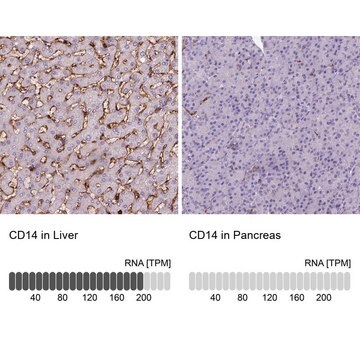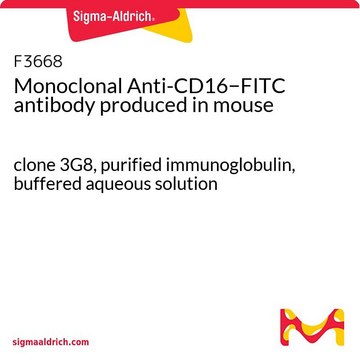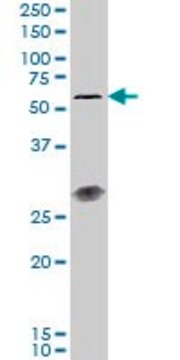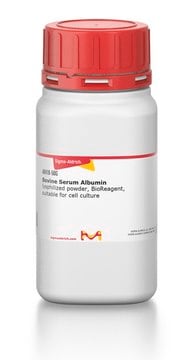C7673
Monoclonal Anti-CD14 antibody produced in mouse
clone UCHM-1, purified immunoglobulin, buffered aqueous solution
Synonym(s):
Monoclonal Anti-CD14
Sign Into View Organizational & Contract Pricing
All Photos(1)
About This Item
UNSPSC Code:
12352203
NACRES:
NA.41
Recommended Products
biological source
mouse
conjugate
unconjugated
antibody form
purified immunoglobulin
antibody product type
primary antibodies
clone
UCHM-1, monoclonal
form
buffered aqueous solution
mol wt
antigen 55 kDa
species reactivity
human
technique(s)
flow cytometry: 5 μL using 1 × 106 cells
isotype
IgG2a
UniProt accession no.
shipped in
wet ice
storage temp.
2-8°C
target post-translational modification
unmodified
Gene Information
human ... CD14(929)
Looking for similar products? Visit Product Comparison Guide
Related Categories
Specificity
The epitope recognized by this clone is sensitive to routine formalin fixation and paraffin embedding. Cryostat sections, post-fixed in formalin can be stained.
3rd Workshop: code no. 203
4th Workshop: code no. M24
3rd Workshop: code no. 203
4th Workshop: code no. M24
Immunogen
human thymocytes followed by peripheral blood T cells.
Application
Monoclonal Anti-CD14 antibody produced in mouse is suitable for the following applications:
- Flow cytometry at a dilution of 5μL using 1 × 106 cells
- Immunofluorescence.
- Immunoblotting.
Biochem/physiol Actions
CD14 gene has an important role during signaling of the innate immune response and in the detection of inflammatory pathogens. It also plays an important role in recognizing tuberculosis (TB) disease and it can be used as a potential biomarker for predicting the prognosis of breast invasive ductal carcinoma with LN+ER/PR-Her2+. It is also associated with asthma, croup and allergy.
Target description
CD14 is a phosphoinositol-linked, single-chain, human cell surface glycoprotein antigen which is found on most human peripheral blood monocytes, granulocytes and dendritic reticulum cells, and some tissue macrophages. CD14 may also be present on B cells. Soluble forms of CD14 are present in serum and urine. The antigen functions as an acceptor for LPS-binding protein complexes.
Physical form
Solution in 0.01 M phosphate buffered saline, pH 7.4, containing 1% bovine serum albumin and 15 mM sodium azide.
Disclaimer
Unless otherwise stated in our catalog or other company documentation accompanying the product(s), our products are intended for research use only and are not to be used for any other purpose, which includes but is not limited to, unauthorized commercial uses, in vitro diagnostic uses, ex vivo or in vivo therapeutic uses or any type of consumption or application to humans or animals.
Not finding the right product?
Try our Product Selector Tool.
Storage Class Code
10 - Combustible liquids
WGK
nwg
Flash Point(F)
Not applicable
Flash Point(C)
Not applicable
Choose from one of the most recent versions:
Already Own This Product?
Find documentation for the products that you have recently purchased in the Document Library.
Weifeng He et al.
PloS one, 8(9), e75366-e75366 (2013-10-03)
In clinical practice, breast cancers with lymph node positive, ER/PR-negative and overexpressed human epidermal growth factor receptor 2 (LN+ER/PR-Her2+) have high risk of recurrence, but the effective biomarkers of prognostic for this type tumor are still lacking. Since breast cancers
Barbara M Rothen-Rutishauser et al.
American journal of respiratory cell and molecular biology, 32(4), 281-289 (2005-01-11)
A novel triple co-culture model of the human airway barrier was designed to simulate the cellular part of the air-blood barrier of the respiratory tract represented by macrophages, epithelial cells, and dendritic cells. When epithelial cells (A549 cells) were grown
J Zhao et al.
The international journal of tuberculosis and lung disease : the official journal of the International Union against Tuberculosis and Lung Disease, 17(11), 1472-1478 (2013-10-16)
CD14 plays an important role in recognising the tuberculosis (TB) antigen and initiating immune response. CD14-159C/T polymorphism has been reported to be associated with susceptibility to TB in some, but not all studies. To comprehensively evaluate the correlation between CD14-159C/T
Donna C Rennie et al.
Disease markers, 35(6), 765-771 (2013-12-19)
The CD14 gene has an important role in the detection of inflammatory provoking pathogens and in the ensuing signaling of the innate immune response. We assessed the role of CD14 C-159T, G-1359T in the expression of asthma, croup, and allergy
Elena M V de Cavanagh et al.
American journal of physiology. Heart and circulatory physiology, 319(4), H744-H752 (2020-08-17)
Patients presenting with classical cardiovascular risk factors within acceptable or average value ranges often develop cardiovascular disease, suggesting that other risk factors need to be considered. Considering that endothelial progenitor cells (EPCs) contribute to endothelial repair, we investigated whether EPCs
Our team of scientists has experience in all areas of research including Life Science, Material Science, Chemical Synthesis, Chromatography, Analytical and many others.
Contact Technical Service







